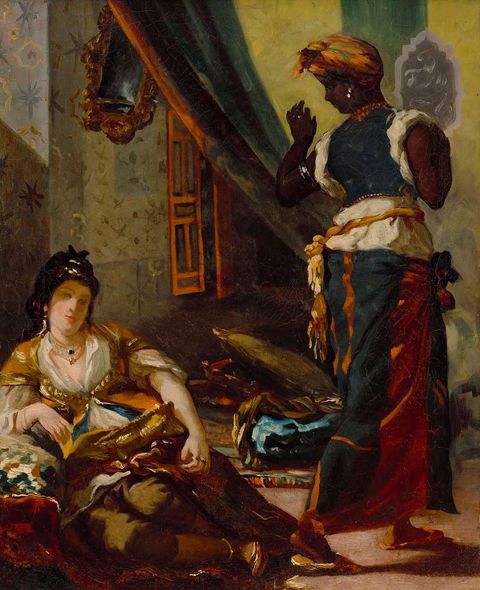Rediscovered after nearly 170 years, a Delacroix painting has been acquired by the Museum of Fine Arts, Houston

Eugène Delacroix, Women of Algiers in Their Apartment,” 1833–34, oil on canvas, the Museum of Fine Arts, Houston, Museum purchase funded by the Brown Foundation Accessions Endowment Fund.
The painting is Delacroix’s first version of his famed Femmes d’Alger in the Louvre; will go on view at the MFAH on October 3
HOUSTON—September 26, 2019—The Museum of Fine Arts, Houston, announced today the acquisition of a newly rediscovered masterwork by 19th-century French painter Eugène Delacroix: Women of Algiers in Their Apartment (1833–34). The painting will go on view at the Museum on October 3.
The work is the first version of Delacroix’s widely acknowledged masterpiece at the Louvre, Femmes d’Alger (1834), which toured as part of the acclaimed 2018 retrospective of the artist, co-organized by the Louvre with the Metropolitan Museum of Art, New York. The whereabouts of the Houston version, last recorded in an 1850 sale, were unknown until 2018, when Paris gallerist Philippe Mendes discovered the painting in the apartment of a Paris collector; she had approached Mendes for authentication. After extensive research and radiographic study, the painting was authenticated by Delacroix expert Virginie Cauchi-Fatiga, and exhibited for the first time in June 2019 at Galerie Philippe Mendes, Paris.
“After months of speculation about the destination of this truly extraordinary painting, I am very pleased to say that Delacroix’s first, long-lost Femmes d’Alger will have a public and permanent home here in Houston,” said Gary Tinterow, The Margaret Alkek Williams Director of the Museum of Fine Arts, Houston. “Women of Algiers in Their Apartment is a landmark addition to our collections.”
The painting, of two women in an ornate, dimly lit interior, is from a pivotal period in Delacroix’s evolution as one of the great Romantic artists of his time. Shortly after France invaded North Africa in 1830, Delacroix, then 32, joined a diplomatic mission to journey there. The mission was headed by the Comte de Mornay, who would eventually acquire the Houston painting from Delacroix (1798–1863), then sell it in 1850, after which it disappeared from public record. In Algiers, the artist depicted a culture then unknown to Europe, sketching and painting in the homes of Moroccan Jewish and Muslim families.
Women of Algiers in Their Apartment depicts the private sanctuary of the women and their maidservants who lived in the home of an Algerian official, who granted the artist brief access. The woman at the left of the canvas is seated on the floor, reclining with her right arm propped on a patterned cushion. Her draped robe is set off by a jeweled necklace and rings. The woman’s maidservant, at right, turns back as she strides past, as if to glance at or respond to the woman. The golden ochre of the maidservant’s skirt and turban echo the other woman’s robe. The two figures of the Houston painting reappear in the larger, horizontal composition of the Louvre painting, with two additional seated figures.
The painting’s surface glints with passages of greens, auburn, and sapphire blue, colors that attest to the profound and enduring influence that the light and colors of North Africa had on Delacroix’s imagination. Despite having spent only four days in Algiers, during his brief stay there Delacroix created a number of sketches and watercolors, noting details of the interiors, the names of the people he painted, and descriptions of clothing. He completed the Houston painting, then the version at the Louvre, on his return to Paris. Delacroix’s third Femmes d’Alger, a much later version from 1847–49, is in the collection of the Musée Fabre in Montpellier, France. Both the Louvre and Montpellier paintings were famously admired by Van Gogh and Gauguin, and by Picasso, who produced his extensive 1954–55 series of paintings, drawings, and prints of the same title in homage.
About the Museum of Fine Arts, Houston
Established in 1900, the Museum of Fine Arts, Houston, is among the 10 largest art museums in the United States, with an encyclopedic collection of nearly 70,000 works dating from antiquity to the present. The Museum’s Susan and Fayez S. Sarofim main campus comprises the Audrey Jones Beck Building, designed by Rafael Moneo and opened in 2000; the Caroline Wiess Law Building, originally designed by William Ward Watkin, with extensions by Ludwig Mies van der Rohe completed in 1958 and 1974; the Lillie and Hugh Roy Cullen Sculpture Garden, designed by Isamu Noguchi and opened in 1986; the Glassell School of Art, designed by Steven Holl Architects and opened in 2018; and The Brown Foundation, Inc. Plaza, designed by Deborah Nevins & Associates and opened in 2018. Additional spaces include a repertory cinema, two libraries, public archives, and facilities for conservation and storage. Nearby, two house museums—Bayou Bend Collection and Gardens, and Rienzi—present American and European decorative arts. The MFAH is also home to the International Center for the Arts of the Americas (ICAA), a leading research institute for 20th-century Latin American and Latino art. mfah.org
Media Contact
Sarah Hobson, publicist
shobson@mfah.org | 713.800.5345
